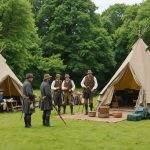Overview of British Witch Trials History
The British Witch Trials present a fascinating yet enigmatic chapter in the annals of the UK’s history. Spanning several centuries, these trials were primarily held from the 15th to the 18th century, deeply rooted in the tumultuous historical context of superstitions and societal pressures of the time.
Key events in this enigmatic history include the infamous Pendle Witch Trials of 1612 and the Salem-inspired Bideford Witch Trial in 1682. These trials took place across numerous locations, most notably in Lancashire, Essex, and Scotland, where community fears propelled accusations and led to trials often based on scant evidence.
Also read : Finding your perfect furnished apartment: a comprehensive guide
The cultural impact of these witch trials has been profound, giving rise to numerous myths and legends that perpetuate the allure of this dark period. Stories of accused witches, trials by ordeal, and spectral evidence have been enshrined in literature and folklore, fueling ongoing fascination. Many of these tales highlight the darker aspects of justice and societal norms during those centuries, painting a vivid picture of how fear and ignorance often drove judicial practices.
Understanding this history helps contextualize modern perceptions of witch trials and challenges the myths that have survived through generations.
Also to see : Discover the art of traditional british textile dyeing: a tourist”s guide to immersive, hands-on workshops
Towns Offering Guided Tours
Guided Tours in the United Kingdom offer a captivating journey through history, immersing visitors in the haunting past of the Witch Trials era. Several UK towns have embraced their witch trial heritage, transforming it into an educational experience through engaging tours. These tours are significant in preserving history, as they bring to life the stories and locations of a once enigmatic history.
Among the most renowned towns for witch trial history are Lancashire, home to the famous Pendle Hill; East Anglia, which endured intense witch hunts; and Bideford, known for the last witch trial in England. Each town offers unique insights and stories through local guided tours.
Tour formats vary widely, ranging from theatrical walks through historical areas to comprehensive museum visits. These tours often adapt to different preferences and schedules, providing options like daytime exhibits, evening ghost walks, and weekend or holiday packages. The availability of such tours promotes a deeper understanding of the historical context while making the experience enriching and memorable for all who attend.
Detailed Tour Descriptions
Exploring guided experiences of the British Witch Trials offers a captivating journey through historical narratives. Below, discover the intriguing elements each location offers through their detailed tour descriptions.
Town Name 1: Overview of Tours
This town offers an enthralling dive into its rich past through guided tours. Key highlights include visits to iconic landmarks where significant witch trials occurred. Notable sites such as the courthouse and ancient dwellings draw the curiosity of many. Tours are often available throughout the week, with varied durations to suit diverse interests.
Town Name 2: Overview of Tours
Visitors to this location can immerse themselves in historical tales through carefully curated historical tours. The experience includes walking through ghostly paths and visiting preserved historical sites. Duration and frequency vary, offering flexibility and an enriching educational journey.
Town Name 3: Overview of Tours
Here, guests can engage with the past through guided experiences showcasing notable historical sites. Highlights involve dramatized retellings of historical events and visits to authentic trial locations. Tours typically run from weekends to weekdays, allowing ample exploration opportunities.
Embarking on these tours offers not only a journey through enriching narratives but also insight into the societal dynamics that characterised this chapter in history.
Historical Significance of Key Sites
Historic Sites related to the British Witch Trials are captivating windows into the past, revealing the socio-political climate that fueled them. These Notable Locations serve as tangible connections to an era marked by fear and superstition. Each site holds significant historic value, contributing to a deeper understanding of the trials.
Pendle Hill, Lancashire: Famous for the 1612 witch trials, this site is steeped in lore. The trials of the Pendle witches rank among the most infamous in English history, where accusations led to the execution of ten individuals. Visiting this historic site provides a haunting glimpse into the fierce paranoia of the era.
Bideford, Devon: Known for England’s last witch trials in 1682, Bideford’s trial involved three women accused of practicing witchcraft, showcasing the declining power of witch accusations. The courthouse and adjacent areas offer a poignant backdrop to the stories of wrongly accused and executed individuals.
These sites not only represent dark chapters of history but also challenge modern perceptions by highlighting the unjust judicial practices of the time. Each offers anecdotes that illustrate the societal dynamics and fears, encouraging reflection and understanding of past and present societal issues.
Visitor Tips for Witch Trial Tours
Exploring the British Witch Trials through guided tours offers a unique view of history, but visitor preparation can enhance the experience. To make the most of these immersive journeys, consider the following visitor tips.
Start by booking tours in advance, especially during peak tourist seasons. Prices for guided experiences vary, with some offering student or group discounts. Check for online reviews or user feedback to choose tours that match your interests and time availability.
Dress comfortably for walking tours, as paths may cover uneven historical terrains. While some tours are indoors, others offer outdoor exploration; bring weather-appropriate clothing and comfortable shoes.
Allow extra time for exploration, and consider opting for guided tours led by knowledgeable historians. They provide deeper insights into the historical context and the most intriguing details of each site or event. Listen to personal anecdotes shared by guides, as these stories often bring the trials to life.
Combining guided visits with museum tours can enhance understanding and appreciation. Engaging in evening or ghost tours can offer a different perspective and add a layer of excitement. Keep a curious mind, and remember to inquire about any self-guided tour options available.
User Reviews and Recommendations
Exploring the Witch Trials history through guided tours has garnered mixed yet insightful user reviews. Visitors consistently praise these experiences for their educational value, particularly the vivid storytelling and authentic atmospheres that guide participants into the past. Many reviews highlight the compelling dramatizations of events, which add a unique and immersive layer to the tours.
A common recommendation from attendees is to prioritise tours led by expert guides. Their profound knowledge and enthusiasm significantly enhance the tour experience, making the connection to history more tangible. Feedback also suggests that tours incorporating interactive elements, such as participating in mock trials or historical reenactments, tend to receive higher ratings.
Ratings and preferences among visitors often spotlight specific towns, such as those with enriched historical backgrounds like Lancashire and Bideford. Unique aspects such as evening or themed tours—particularly those conducted around Halloween—are celebrated for adding a touch of excitement and novelty. Reviewers advise fellow travellers to make use of discounts and book in advance to secure spots in these popular tours, especially during busy seasons. These insights illustrate how user reviews can preemptively shape a rewarding visit, guiding others in crafting their memorable historical journeys.










